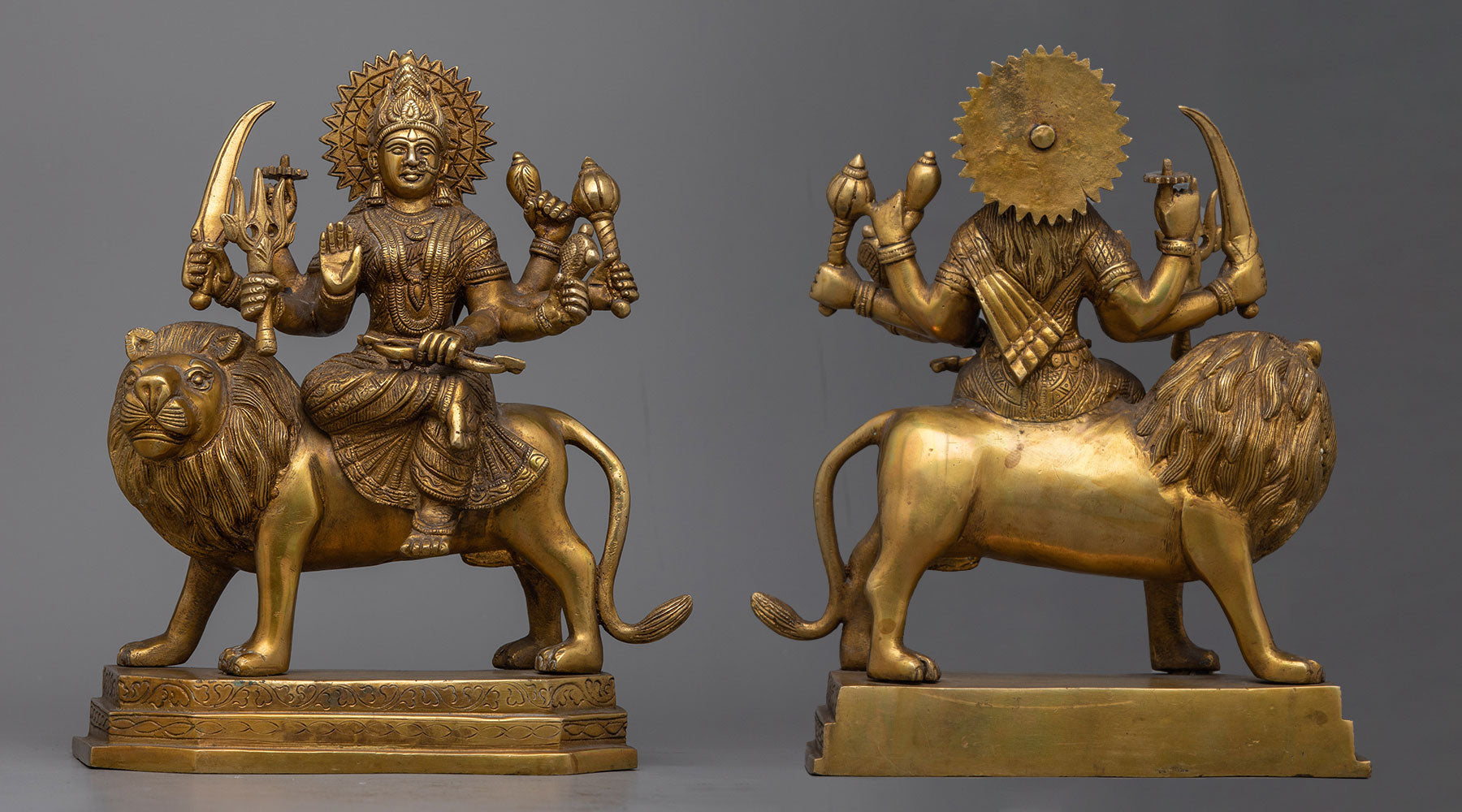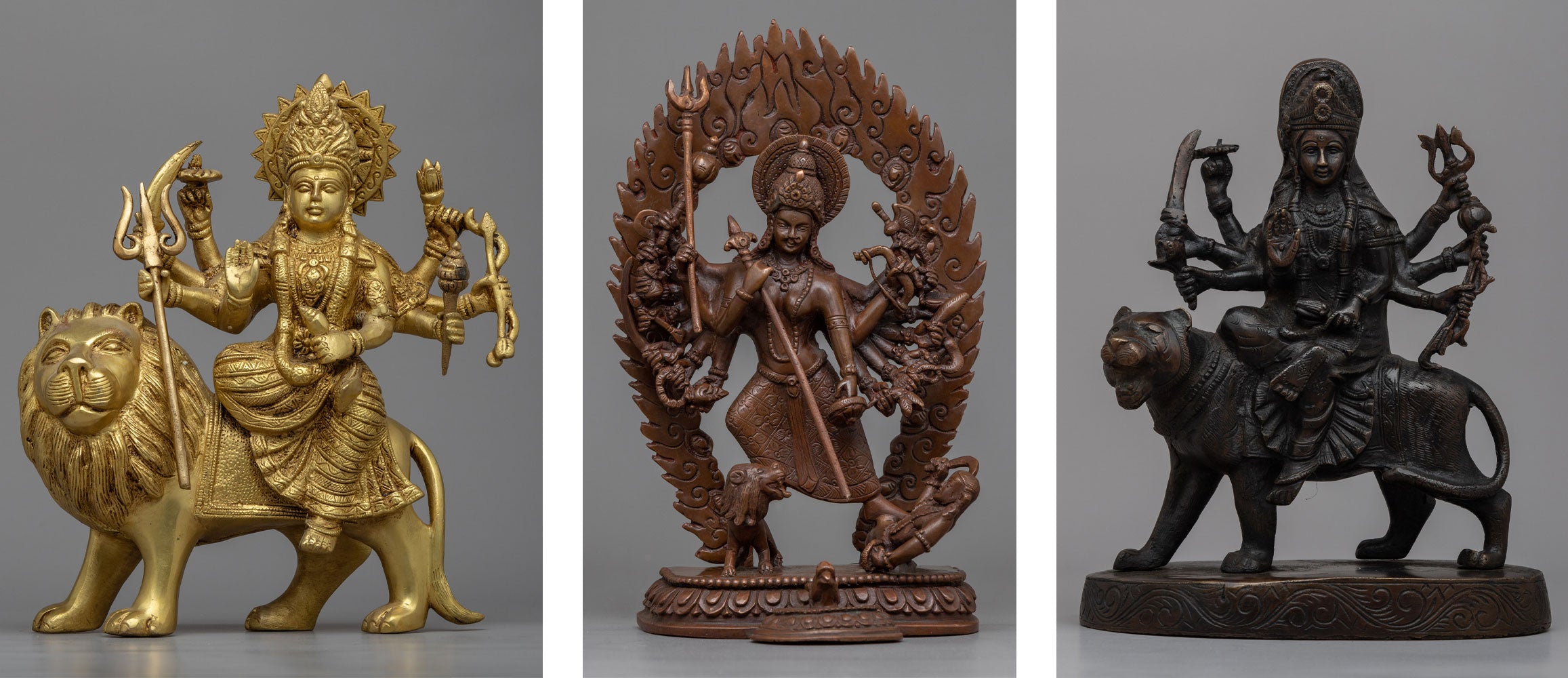Exploring the Spiritual Significance of Durga Maa in Buddhism
Durga Maa, revered for her strength and protective abilities, plays a pivotal role in Hinduism and Buddhism, especially within its Tantric sects.
Her presence in Hinduism and Buddhism emphasizes her importance as a symbol of protection, power, and the victory of good over evil.
Although her portrayal and worship differ across these religions, the fundamental essence of Durga as a guardian deity transcends religious divides, showcasing the mutual respect for the potency of the divine feminine in South Asian spiritual customs.
Key Takeaways
- Durga Maa is revered in Hinduism and Buddhism, symbolizing the triumph of good over evil.
- She is a Hindu warrior goddess, embodying Shakti (power) and protection.
- In Buddhism, particularly Vajrayana, she is viewed as a protector deity or a Dakini, representing spiritual energy.
- The festival of Navaratri in Hinduism and the practice of Chöd in Buddhism are significant to her worship.
Durga Maa in Hinduism

Click here to view our Durga Maa Statue
Origins and Significance
Durga Maa, a central figure in Hindu mythology, is believed to have originated from the collective energies of the gods to conquer the buffalo demon, Mahishasura. Her name, meaning "the inaccessible" or "the invincible," highlights her supreme power and warrior nature.
Depictions often portray her riding a lion or tiger, wielding multiple arms adorned with weapons from various deities, symbolizing her diverse divine attributes.
Worship and Festivals
One of the most notable festivals dedicated to Durga Maa in Hinduism is Navaratri, a nine-night celebration commemorating her triumph over Mahishasura.
This festival is observed throughout India with fasting, dancing, and intricate rituals. Durga Puja, prominently celebrated in West Bengal, forms a significant part of the Navaratri festivities, featuring elaborate idols depicting Durga's defeat of Mahishasura.
| Festival | Date | Significance |
| Navaratri | September-October | Celebrates Durga's victory over Mahishasura |
| Durga Puja | Part of Navaratri | A significant event in Bengal, the worship of Durga idols |
Durga Mata Goddess in Buddhism
- Tantric Buddhism and Durga Devi
Within Tantric Buddhism, specifically the Vajrayana tradition, Durga Lord assumes the role of a protective deity or Dakini.
Unlike Hinduism, her presence in Buddhism is more nuanced, emphasizing spiritual safeguarding and guiding practitioners toward enlightenment. Her significance in Buddhism lies in her association with converting negative energies into positive spiritual forces.
- Practices and Rituals
A notable practice in Tibetan Buddhism, Chöd, involves invoking Durga's protective aspect. Practitioners symbolically offer their bodies to demons and spirits, aiming to sever attachment to the self and comprehend the emptiness of phenomena. This ritual underscores Buddhism's interpretation of Durga as a guardian against ego and ignorance.
"Durga Puja 2024 : Wed, Oct 9– Sun, Oct 13"
Comparative Analysis of Durga God in Hinduism & Buddhism
Similarities
- Both religions regard Durga as a powerful protector.
- Iconography in both traditions emphasizes her martial aspect and multiple arms.
- Durga is associated with the lion or tiger in both religions, symbolizing her power and ferocity.
Differences
- In Hinduism, Durga is more prominently portrayed as a warrior goddess who directly engages in battle with evil forces.
- Buddhism focuses on Durga's spiritual protection and guidance towards enlightenment, with less emphasis on her martial abilities.
- Rituals and practices related to Durga in Buddhism, such as Chöd, are distinct from Hindu worship and festivals like Navaratri.
Durga Gayatri Mantra
Ma Durga, revered in Hinduism and Buddhism, embodies protection, strength, and the triumph of good over evil. While predominantly linked with Hinduism, her essence and attributes find recognition in select Buddhist traditions, particularly in Vajrayana Buddhism, where she is occasionally likened to specific protector deities or Dakinis.
In Hindu tradition, the Durga Gayatri Mantra is one of the most renowned mantras associated with Durga Maa. Though not originally part of Buddhist texts, its protection, and spiritual elevation themes resonate with Buddhist principles. Here is the mantra:
"Durga Gayatri Mantra
Om Girijayai Vidmahe,
Shiva Priyayai Dhimahi,
Tanno Durga Prachodayat."
Breakdown of the Gayatri Mantra
- Om: The universal sound, the absolute, the source of all existence, the past, the present, and the future.
- Girijayai: This refers to Girija, another name for Durga, who was born on the mountain, highlighting her connection with nature and strength.
- Vidmahe: To understand or comprehend. It indicates invoking Durga Maa in meditation.
- Shiva Priyayai: The beloved of Shiva. Durga is considered Lord Shiva's consort, symbolizing the union of power and consciousness.
- Dhimahi: We meditate upon or focus our minds.
- Tanno Durga: To that Durga (referring to the goddess).
- Prachodayat: May inspire or direct. It is a prayer for Durga's guidance and enlightenment.
Benefits of the Mantra
- Protection: Calling upon Durga Maa for her protective shield against negative energies and influences.
- Strength & Courage: Harnessing courage and strength to confront challenges and overcome obstacles.
- Spiritual Growth: Facilitating spiritual development and enlightenment by directing the mind towards divine energy.
- Harmony & Peace: Fostering inner peace and harmony through balancing energies.
- Purification: Utilizing the mantra for purifying the mind and body, contributing to a healthier life.
Durga Maa, predominantly a figure of Hindu mythology, also holds importance in Buddhist traditions, notably within the Tantric practices of Vajrayana Buddhism.
Her iconography, replete with symbols, signifies her role as a protector and fierce opponent of evil. Understanding Durga's physical attributes and symbols offers insight into her significance across these spiritual traditions.
Physical Attributes & Iconography of Durga Goddess

Multiple Arms
Durga Mata is commonly portrayed with eight to ten arms, each holding a weapon or symbolic item. These arms signify her capacity to carry out numerous tasks concurrently and represent the diverse powers (Shaktis) of the cosmos she embodies.
Each weapon she wields is bestowed by a different deity, symbolizing the combined strength of all gods in the battle against negativity and hostility.
Weapons
The weapons Durga holds are significant, as each represents a specific aspect of her divine power:
- Trishul (Trident): Bestowed by Shiva, it signifies the eradication of ignorance and the three fundamental qualities of nature (sattva, rajas, and tamas).
- Sudarshana Chakra (Discus): Given by Vishnu, it symbolizes the mind's capacity to control and overcome evil.
- Bow and Arrow: Represents energy in its potential and kinetic forms, focus, and determination.
- Sword: Symbolizes knowledge and wisdom, cutting through ignorance.
- Lotus: A representation of purity, detachment, and spiritual enlightenment.
- Conch: Signifies the primal sound (AUM) and the dissemination of the divine word.
Mount - The Lion or Tiger
Durga is often depicted riding a lion or tiger, symbolizing her boundless power and dominion over all forces. The mount signifies will, strength, and resolve, reflecting Durga's role as a guardian and warrior against injustice and enmity.
Appearance
Goddess Durga is portrayed as a graceful woman with a tranquil expression, embodying elegance, nobility, and divine wrath against evil. Descriptions of her complexion vary in texts, ranging from golden to red, symbolizing her purity, ferocity, and maternal nature.
Mudras (Hand Gestures)
Maa Durga's hand gestures, or mudras, symbolize her teachings and blessings. The Abhaya (fearlessness) and Varada (boon-giving) mudras are commonly associated with her, representing protection, tranquility, and the blessings she bestows upon her followers.
Symbolism in Iconography of the Deity
The iconography of Durga Lord is profoundly symbolic, depicting the victory of good over evil, the dissolution of ego and ignorance, and the defense of righteousness.
Her portrayal transcends mere artistic expression, serving as a narrative of cosmic and spiritual principles. Each element of her iconography carries deep significance, reflecting her role as a divine mother, guardian, and mentor for her devotees.
In Buddhist contexts, particularly in the Himalayan regions and within Vajrayana Buddhism, Durga's attributes and symbolism sometimes intersect with or parallel those of Buddhist deities like Tara or Vajrayogini.
These figures also embody feminine strength, compassion, and the principle of Shakti (divine energy), highlighting the universal reverence for the potency and wisdom of the sacred feminine.
The Legend of Durga Maa & Mahishasura

Click here to view our Hindu Deity Statues
The Legend of Durga Maa and Mahishasura begins with Mahishasura, a mighty demon who earned a boon from Lord Brahma, rendering him invulnerable to gods and men.
With this newfound power, Mahishasura wreaked havoc across the three realms, conquering the heavens and driving out the gods.
In desperation, the celestial beings turned to the Holy Trinity - Brahma, Vishnu, and Shiva - for assistance. Answering their prayers, a radiant light emanated from the Trinity, merging into the form of the goddess Durga.
Bestowed with weapons and powers by other deities, Durga mounted a lion, her countenance radiating divine fury, prepared to confront evil.
The clash between Durga and Mahishasura endured for 10 days. Despite underestimating Durga due to her gender, Mahishasura soon realized her formidable prowess.
He transformed his shape multiple times, from buffalo to lion, man, and elephant, attempting to outmaneuver the goddess. However, Durga remained steadfast and adept, swiftly adapting to each transformation, ultimately subduing Mahishasura in his buffalo form.
By comprehending the multifaceted role of Durga Maa, one gains insight into the diverse array of religious beliefs and rituals in this region, illustrating the intricate dynamics among various faiths and their perceptions of divine entities.














